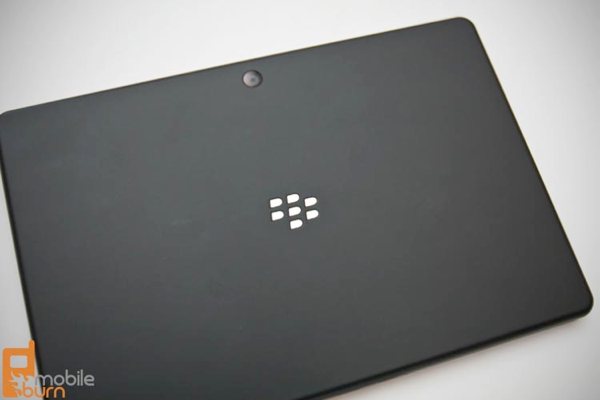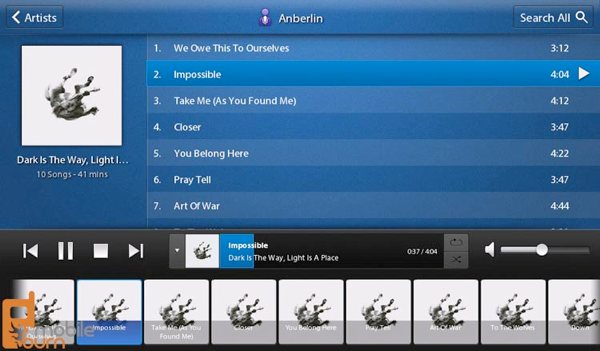Camera, Music, Battery, Conclusion
Camera
The PlayBook is equipped with two cameras: a 3 megapixel one up front and a 5 megapixel shooter at the back. Neither have autofocus or a flash, but both are capable of recording 1080p HD (1920 x 1080) video.

The front camera provided good quality considering its primary purpose: video conferencing. The picture is sharp and not too grainy (although we couldn't test a video call due to the lack of a video calling app). The rear camera is more disappointing. It was surprisingly sluggish to take a picture, providing a lot of lag after pressing the on-screen shutter button. We missed a number of shots because we moved the tablet away before the camera had actually snapped a picture. When outdoors, images had acceptable colors and were sharp enough, if a bit over-compressed. Indoors, things turned into a bit of a mess, exhibiting a large amount of blur and grain. The shutter lag only worsened when indoors.
Video quality was acceptable from the rear camera, but we have yet to see an appreciable benefit of having 1080p resolution over the 720p recording of many of today's mobile devices. The video was quite compressed, although the frame rate was good when there was enough light.
The gallery app that comes pre-installed on the PlayBook was nice to use and responsive. Flicking through photos was a breeze and there is a nifty layering effect in the transitions. Pinch-to-zoom worked well and was nice and fast. The biggest flaw was there was no easy way to share a photo outside of the PlayBook. Since the PlayBook does not have a native email app, nor a native Facebook or Twitter client, the only way to send someone a photo from it is to load a webpage and manually upload the file; a cumbersome method to say the least. Sharing photos immediately after taking them is one of the beauties of having a camera on a mobile device, and we missed it greatly with the PlayBook.
Music
The PlayBook's support for music is good, and users can load up the tablet with their own music via USB or Wi-Fi. The player supports album art and playlists, and users can easily search through the music library. Playback of a song will continue in the bottom portion of the app, allowing users to browse the other areas of the app while a song continues in the background. The music player supports multitasking, and a control will appear in the top status bar of the main screen so that users can play/pause and skip tracks when they are working in an entirely different app. Sound quality was really, really good from the built-in stereo speakers, and the volume could be cranked all the way without any noticeable distortion or crackling. The PlayBook was able to fill a room with music without breaking a sweat.

RIM has included a Music Store app powered by 7digital that allows users to buy new songs and albums. Songs are a bit more expensive than from other music stores, ranging from $0.99 to $1.99 a track, whereas albums could be anywhere from $5 all the way up to $11.99. The music selection is good nonetheless.
Also pre-installed is a Slacker radio app for streaming music to the PlayBook. RIM was smart to include this at launch as there is no Pandora app available as of yet. The Slacker app worked well and buffering was kept to a minimum when the PlayBook's Wi-Fi would cooperate. Some of the buttons were not very responsive in the app, though, and at times we would get frustrated when changing tracks or stations.
Battery
RIM has outfitted the tablet with a massive 5400mAh battery that can power the device for a solid day of use. The company has been coy about the expected battery life, but we were able to go all day without charging it up. While the battery life doesn't seem to be as stellar as the iPad's, we think that most users will be quite pleased. Like most other tablets on the market today, the battery is not user swappable.
Final Thoughts
As we have seen throughout this review, the BlackBerry PlayBook offers a lot to like, and a lot to hope for. The user experience is solid, it can be a joy to use, and we rarely found issues with crashing or instability.
Unfortunately, that is not enough to succeed in today's highly-competitive tablet market. Besides a great browser, users want apps, solid email support, messaging, and more from their tablet devices. Without these standard items, the PlayBook is just a web browser, a mediocre camera, and possibly an oversized music player. RIM has promised many additions to the platform in the future, but until those arrive, it is tough to recommend the PlayBook over similarly priced options. RIM is selling the Wi-Fi-only PlayBook with 16GB of storage for $499, with options for 32GB and 64GB models costing $599 and $699, respectively. That is a tough sell when Apple's proven and successful iPad 2 costs the same.
For now, we are going to put this in the wait-and-see category. The experience of the PlayBook could change drastically with a few additions, so hopefully RIM will speed up the development of those missing pieces and get them to market right away. The question is, can RIM afford to be in the waiting pile, and how long will it linger there?
Pros:
|
Cons:
|
Dan Seifert is a contributing editor at MobileBurn.com. MobileBurn focuses on cell phones, smartphones, tablets, and related hardware. Republished with permission.